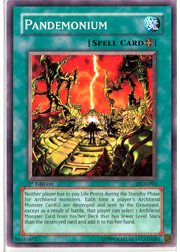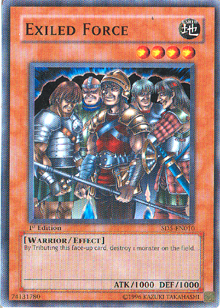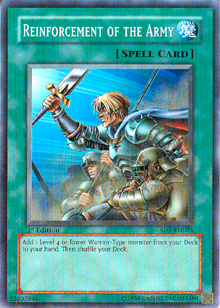The Apotheosis: Total Pandemonium
Hand manipulation. If there’s one concept that can truly terrify your opponent, it’s messing with the options he or she thought were safe. Sure, OTKs are a rough beat, but at least they’re over and done with quickly. You get to pick up your shattered pride and move along with your day. But when Don Zaloog forces your Brain Control into the graveyard while you’re holding a Monarch, or a timely Confiscation steals the best card from your opening hand, only one thing is certain: you’re in for a long uphill battle.
Losing just a single unplayed card hurts virtually any deck, especially in this day and age where so many strategies are centered on game-winning combos. Sure, obstacles are more common than ever before: once we only had to worry about discarding Sinister Serpent, but some decks now pack as many as three copies of Destiny Hero - Malicious, one Destiny Hero - Disc Commander, and perhaps even Treeborn Frog. That’s five cards that you would be better off not discarding. Some competitors might tell you that this trend has created metagames where hand destruction just isn’t very good. I’ll tell you that those duelists aren’t thinking big enough.
If your opponent has a card in hand that he or she doesn’t mind discarding, the solution is simple: discard more cards. Three of them in fact, all at once. That’s exactly the tempting premise today’s deck submitter, Josh, placed before me.
I’ve been toying with an idea for a long while, but it seemed too far-fetched. Then Force of the Breaker was released, giving us Archfiend General. The idea is to use Mazera Deville, especially first turn so I can drop it, rob my opponent of three cards, and summon a 2800 ATK monster before they can even make a move.
All of the pieces, with the exception of Mazera itself, are highly searchable. There’s Reinforcement of the Army to search for Warrior of Zera, and Archfiend’s General for Pandemonium. Once I get Mazera off, the rest of the Archfiend support becomes more brutal since I’ve robbed the opponent of options. Running Warrior of Zera and Reinforcement of the Army, I decided to splice in a Warrior/Archfiend strategy. The deck has a clear goal. I just need help making sure I can achieve it, and be able to survive if it doesn’t come together right away.
—Josh B.
Houston, TX
Pretty cool, huh? Sure, you lose one card (Warrior of Zera) and commit two to the field, but one of those happens to be an absolutely gargantuan monster. The raw card advantage isn’t even the point: the incredible ability to simplify the duel and put your opponent on the defensive as early as turn 1 is simply remarkable, and makes this seemingly outlandish strategy well worth exploring. Here’s what Josh’s deck looks like . . .
Total Pandemonium: 40 Cards
Monsters: 21
3 Mazera Deville
 3 Warrior of Zera
3 Warrior of Zera
2 Cyber Dragon
3 Archfiend General
2 Terrorking Archfiend
1 Shadowknight Archfiend
1 Desrook Archfiend
1 D. D.Warrior Lady
1 Elemental Hero Stratos
2 Elemental Hero Wildheart
1 Jinzo
1 Thestalos the Firestorm Monarch
Spells: 13
3 Pandemonium
2 Reinforcement of the Army
1 Heavy Storm
1 Mystical Space Typhoon
1 Snatch Steal
2 Smashing Ground
1 Rush Recklessly
1 Premature Burial
1 Nobleman of Crossout
Traps: 6
1 Mirror Force
1 Torrential Tribute
1 Ring of Destruction
1 Call of the Haunted
2 Sakuretsu Armor
Josh voiced two concerns: consistency in pulling off Mazera Deville’s summoning, and the ability to keep himself alive when Mazera doesn’t materialize on turn 1. I like where Josh has started the deck, but I have a concern of my own.
Once Mazera hits the field, it has the potential to become a dominating force, but Josh has done nothing to protect it. Mazera’s effect may force the opponent to discard his or her Smashing Ground, Brain Control, or Snatch Steal cards, but that’s still a gamble, and I don’t feel the deck has a clear purpose once Mazera lands on the table. I’d like to protect this deck’s field presence while focusing on cards that can continue simplifying the duel. From there, I can retool the monster lineup to both create and capitalize on simplified game states.
I’ll start by dropping the monsters that don’t comply with this initiative. First, the deck isn’t running any monsters that help to enable tributing, so Jinzo and Thestalos aren’t a natural fit. Sure, big bodies are nice to have when there are very few cards on both sides of the table, but it seems shortsighted to rely on monsters with relatively low utility instead of our handy Warrior toolbox. Jinzo and Thestalos will both be removed.
Shadowknight Archfiend is an intriguing card, but it really doesn’t seem worthwhile when Terrorking Archfiend is so much better. Sure, you may have to set the Terrorking on occasion, but there are relatively few monsters that see frequent play nowadays with an ATK high enough to punch through the Terrorking’s 1500 DEF. Most of them are tribute monsters, and the rate at which we’ll be simplifying the duel should make it difficult for your opponent to use any. Cyber Dragon will pose a problem, but Terrorking and Shadowknight both have 2000 ATK anyways, so by removing the Shadowknight and leaving the Terrorkings, we’re making a small step towards mitigating this problem. Rest assured there will be more such steps to follow.
Desrook Archfiend takes advantage of Pandemonium’s “go get an Archfiend of a lower level when a bigger one is destroyed” effect, but I just don’t feel it’s worth the space. I want more room for searchable Warrior-types, and while it may seem wasteful to never use one of Pandemonium’s effects, it’s important to remember that it’s here primarily for Mazera anyways. Desrook will be dropped.
I’d like to remove Elemental Hero Stratos and the pair of Elemental Hero Wildheart cards from this deck. Yes, these three cards create a powerful offensive suite. However, they do not encourage the simplification that I want to pressure the opponent with, and all three fall in battle to Monarchs and Cyber Dragon without giving any resistance. I need monsters that fulfill my priorities, not ones that just happen to be good in the most general sense.
Lastly I’ll drop the one copy of Rush Recklessly as well as Call of the Haunted. I personally shy away from Rush in favor of direct monster removal unless I’m playing something that offers a strong combo, like Hydrogeddon. In that case, Rush Recklessly is a great choice: it fills a defensive gap while enabling a big, splashy play that can win games. In this deck, however, Rush is merely a conditional defensive card and slight offensive enabler. It’s useless when you don’t have a monster out, and since this deck intends to force topdecking situations, I’d really rather not run cards that are useless on their own. The fact that we’re already running three Pandemonium cards is enough of a liability.
As for Call, well, you’ll understand its removal once you see the monsters I add. Though it has synergy with Archfiend General and Terrorking Archfiend, it can’t be used with Mazera Deville and several of the cards I’ll be employing. Premature Burial will fill our need for graveyard recursion.
With nine open card slots, we can begin making additions! I’ll start with a third Cyber Dragon, due to its strength in topdecking situations and its value as part of a solid, aggressive early game. I’ll add two copies of D. D. Assailant too. Assailant will act as an answer to opposing beatsticks, but it’s also a powerful tool for forcing simplification. Because the Assailant usually demands a card-for-card trade when it’s face up on the field, it can be incredibly difficult to deal with. If it runs over a monster before it’s destroyed and costs your opponent a card, that’s even better, and its 1700 ATK can attack through many popular monsters in the current environment. Assailant makes a great defensive play when set face down, and its status as a Warrior makes it searchable. It’s the perfect choice given this deck’s challenges.
 Next I’ll add some more Warriors, in the form of two Exiled Force cards. With three Cyber Dragon cards, the use of Exiled Force will often permit attacks for 2100 damage, and the simplification this deck creates will make it easy to tell when this ambitious move is wise. Exiled Force is also another measure to protect ourselves from big attackers. Just remember—there are plenty of face-down monsters seeing play nowadays that simply don’t mind being destroyed. Be careful when you send Exiled to destroy a face-down monster.
Next I’ll add some more Warriors, in the form of two Exiled Force cards. With three Cyber Dragon cards, the use of Exiled Force will often permit attacks for 2100 damage, and the simplification this deck creates will make it easy to tell when this ambitious move is wise. Exiled Force is also another measure to protect ourselves from big attackers. Just remember—there are plenty of face-down monsters seeing play nowadays that simply don’t mind being destroyed. Be careful when you send Exiled to destroy a face-down monster.
A third Sakuretsu Armor takes the place of the Rush Recklessly I removed earlier, providing a bit more protection to help us keep attackers on the field. That leaves three slots open for what I feel is the most important change I’m going to make.
Magic Drain is incredible when your opponent has very few cards at his or her disposal. It can force your opponent to commit cards where he or she didn’t expect to, it removes cards from the scope of the duel, and it protects you from the Brain Control/Monarch plays that can disrupt this deck even after it goes off with Mazera. Playing three copies, you’ll be stunned at how often it keeps Mazera or Cyber Dragon on the field, leaving your opponent to dejectedly set a monster in hopes of buying time. Virtually every big play in this format is dependant on spell cards, and Magic Drain combines with all our forced simplification to rout them. This is the lynchpin Josh’s deck truly needed.
Let’s review the changes I made:
-1 Jinzo
-1 Thestalos the Firestorm Monarch
-1 Shadowknight Archfiend
-1 Desrook Archfiend
-1 Elemental Hero Stratos
-2 Elemental Hero Wildheart
-1 Rush Recklessly
-1 Call of the Haunted
+1 Cyber Dragon
+2 D. D. Assailant
+2 Exiled Force
+3 Magic Drain
+1 Sakuretsu Armor
The final build of Josh’s concept looks like this!
Total Pandemonium: 40 Cards
Monsters: 19
3 Mazera Deville
 3 Warrior of Zera
3 Warrior of Zera
3 Cyber Dragon
3 Archfiend General
2 Terrorking Archfiend
1 D. D.Warrior Lady
2 D. D. Assailant
2 Exiled Force
Spells: 12
3 Pandemonium
2 Reinforcement of the Army
1 Heavy Storm
1 Mystical Space Typhoon
1 Snatch Steal
2 Smashing Ground
1 Premature Burial
1 Nobleman of Crossout
Traps: 9
1 Mirror Force
1 Torrential Tribute
1 Ring of Destruction
3 Sakuretsu Armor
3 Magic Drain
When you have the Mazera Deville combo on turn 1, it’s your no-brainer opening. If you can bring out Mazera and set Magic Drain, you’re officially sitting pretty, and your opponent is going to have to do something big to pull out. Even when he or she does, odds are good that it will take his or her entire hand to do it, and that leaves you with a significant advantage on your second turn. From there, all you have to do is use your Warrior toolbox and your superior hand presence to pick your opponent apart. Those games? They don’t last long.
In games where you don’t have the combo, you’ll want to begin simplifying the duel for two reasons. First, fewer cards in the game means a more devastating Mazera when it finally arrives. The opponent can lose his or her entire hand, and will have a lower chance of being able to deal with Mazera and its 2800 ATK. Second, a smaller game with fewer monsters means more time for you to draw into your combo, since there won’t be as many attacks to fend off or absorb. You have five monsters, three spells, and six traps that can create card-for-card trades with monsters that threaten you. That’s fourteen outs total—seventeen if you count Premature Burial and Reinforcement of the Army for their ability to seek out Exiled Force. You can (and will) keep monsters off the field.
Ideal opening plays include setting D. D. Assailant or D. D. Warrior Lady, with a set Terrorking Archfiend reinforced by Sakuretsu Armor or Magic Drain also being acceptable. The lack of self-replacing defensive monsters can be daunting for today’s duelist, but remember that this deck plays aggressively and aims to eliminate field presence instead of preserving it. The speed at which it operates more than makes up for the risks it faces . . . the most significant of which are dead cards. Warrior of Zera is at least a handy mid-sized attacker on his own, but Mazera Deville and Pandemonium just don’t do much until you have the matching cards for your combo. In addition, there isn’t any room in the deck for something to help you deal with this problem, such as Lightning Vortex or Snipe Hunter. Still, you have the capability to force a fast pace, and the average opponent just isn’t ready for that. Play to your strengths and don’t move into turtle mode if it isn’t necessary.
This deck is a blast, and can definitely be competitive at the local or Regional level. More than that, the look on your opponent’s face when you make him or her discard three cards out of five on turn 1 is just awesome. You’ll play Mazera and declare its effect, and the opponent just won’t believe you. He or she will ask to read it, reluctantly discard three cards, and by the time it all sinks in, you’ll be in your next round.
I dare you to tell me that doesn’t sound like fun. Try the deck—you’ll love it.
—Jason Grabher-Meyer
Got a cool deck that you think could benefit from some advice? Send me a decklist in the format shown in this article, along with your name, location, and a couple of paragraphs describing how the deck works. You can reach me at jdgmetagame@gmail.com.